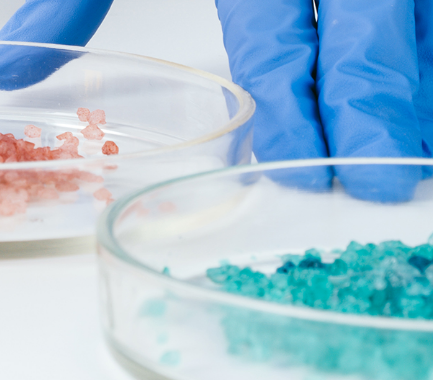Your contact
PENPET-Team - Hamburg

Laurens Rogowski
Sales
Tel. +49 (0) 40 - 675 7 99 80
sales@penpet.de
Get in touch with us.
Alpha-Methylstyrene (AMS)
Alpha-methylstyrene (AMS) is an organic compound from the group of vinyl toluenes, which is an important intermediate in chemical industry processes. The substance is a by-product of the production of acetone and phenol in the cumene hydroperoxide process, but can also be obtained directly from the hydrogenation of cumene.
The compound serves as a starting material for syntheses in organic chemistry. Alpha-methylstyrene is used, among other things, for the production of polymer plastics, synthetic resins and plasticizers. It is also used as a solvent.
At PENPET, you can get alpha-methylstyrene (AMS) of the highest quality, from a reliable partner who will also meet your requirements in the long term. We look forward to receiving your inquiry for an individual offer. Prompt delivery of the liquid can be in bulk in road tankers or containers, as well as in IBC packs and drums of various weights.
CAS no. 98-83-9
EINECS no. 202-705-0
Molecular formula: C9H10
Synonyms: alpha-methylstyrene, isopropenylbenzene, 2-phenyl-1-propene, 2-phenylpropene, beta-phenylpropylene, AMS
Areas of application: Starting material for the production of plasticizers and synthetic resins, comonomer for polymerization
More Information
Alpha-methylstyrene (AMS) is an aromatic compound: its structure is derived from styrene. It consists of an unsaturated phenyl ring with an attached vinyl radical, the central carbon atom of which also has a methyl group. The double bond of the vinyl group is between the middle and the terminal carbon atom. Unlike the similarly named substances 2-methylstyrene, 3-methylstyrene and 4-methylstyrene, the eponymous methyl group is not directly attached to the phenyl structure. Another isomer, beta-methylstyrene, exists in which the methyl group is also attached to the vinyl radical, but to its terminal carbon atom, so that it extends it into an unbranched propene structure. Due to the unsaturated character of the phenyl ring it contains and the double bond of the vinyl radical, alpha-methylstyrene is very reactive. In particular, it can undergo various addition reactions and is suitable as a comonomer for polymerization processes.
Under normal storage conditions, alpha-methylstyrene (AMS) is a viscous, oily and hardly volatile liquid. The compound is colorless and has a sharp, characteristic odor. With strong cooling, the substance gradually changes into a molten state, and solidifies at -23 °C to form a solid. Alpha-methylstyrene boils at a temperature of 166 °C. The compound is practically insoluble in water, and due to its lower density it floats on water. On the other hand, alpha-methylstyrene is very soluble in numerous organic solvents, such as acetone, ethanol, heptane, carbon tetrachloride, chloroform, and benzene.
The compound is polymerizable. If alpha-methylstyrene (AMS) is heated, the added stabilizer can become ineffective. In this case, uncontrolled polymerization of the substance with the formation of explosive gases can occur. Alpha-methylstyrene sometimes reacts violently with strong oxidizing agents. The substance forms unstable and explosive peroxides in air. The compound attacks copper and aluminum.
Alpha-methylstyrene is combustible, but can only be ignited at temperatures well above 400 °C. However, the vapors of the compound can form ignitable and explosive mixtures with the ambient air even if they are heated slightly. Due to its high density, the vapors from the substance collect on the ground. Dangerous long-distance ignitions can occur as a result of uncontrolled spread in the work rooms. Open containers of the substance should therefore be kept well away from sources of ignition such as open flames, mechanically generated sparks, electrostatic discharges, and hot surfaces. Burning alpha-methylstyrene produces acrid and noxious gases. Among other things, larger amounts of carbon monoxide can be released.
Alpha-methylstyrene (AMS) is an irritating hazardous substance which, if consumed in concentrated form, can cause significant signs of poisoning in the metabolism. Direct contact with the liquid can cause severe redness, painful irritation, and degreasing of the skin. With repeated contact allergic reactions and the development of dermatitis are possible. Affected parts of the body should be rinsed immediately with water and soap. If symptoms persist, seek medical help. In the eye, the compound can also cause burning pain, sudden tears and conjunctivitis. After exposure, the eye should be rinsed thoroughly with water. In addition, an ophthalmological examination must be arranged immediately.
Inhaling aerosols and vapors of the substance can cause irritation in the nose, throat and lower respiratory tract. Prolonged exposure to concentrated vapors may cause pneumonia and edema. If the compound is swallowed, immediate vomiting is to be expected with an increased risk of aspiration. If alpha-methylstyrene is absorbed into the metabolism, disorders of the central nervous system, cardiovascular functions, and organ damage can occur. Therefore, if poisoning is suspected, it is urgent to initiate a medical examination with subsequent medical observation of possible symptoms.
Alpha-methylstyrene can cause considerable damage to aquatic organisms and is considered to be clearly hazardous to water. Escape of the compound into the environment must be avoided. The responsible authorities must be informed if large quantities of the substance escape into the ground, the sewage system or bodies of water. As a hazardous substance, alpha-methylstyrene is subject to special transport regulations.
